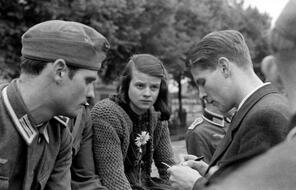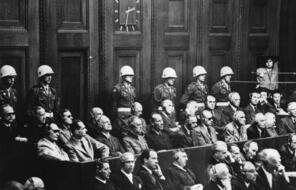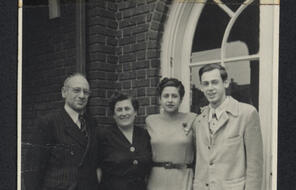Obeying Orders
At a Glance
Language
English — USSubject
- History
- Social Studies
- Human & Civil Rights
- The Holocaust
A Plea for Humanity: The Einsatzgruppen on Trial
A previous version of this newly revised reading was titled “We Were Not Supposed to Think.”
After the first trial ended in October 1946, the United States held 12 other trials at Nuremberg under the authority of the International Military Tribunal. Among those brought to trial were
- 26 top military leaders;
- 56 high-ranking SS and other police officers, including 24 leaders of the Einsatzgruppen (mobile killing units) and key officials in Heinrich Himmler’s central office, which supervised the concentration camps and the extermination program;
- 23 doctors who participated in the Nazi medical killing program that targeted mentally and physically disabled people and conducted experiments on camp prisoners; and
- 14 officials of other Nazi organizations that engaged in racial persecution.
Few defendants at any of the trials denied the accusations made against them, and often their own testimony was used to convict them. Otto Ohlendorf, the former commandant of Einsatzgruppe D, was sentenced to death for the murder of about 90,000 Jews, Roma, and Sinti after admitting that he had ordered his men to kill children as well as adults. His defense was simple: he was just following orders. Another defendant, Rudolf Höss, the commandant at Auschwitz, used the same defense. He explained:
Don’t you see, we SS men were not supposed to think about these things; it never even occurred to us. . . . We were all so trained to obey orders without even thinking that the thought of disobeying an order would simply never have occurred to anybody, and somebody else would have done just as well if I hadn’t. . . . I really never gave much thought to whether it was wrong. It just seemed a necessity. 1
The judges at Nuremberg rejected the “following orders” defense. They said that when an individual follows an order that is illegal under international law, he is responsible for that choice, except under certain circumstances. For instance, if the individual could prove that he was ignorant of the fact that the order was illegal, he would not be responsible. But the judges at Nuremberg maintained that it would have been impossible for members of Einsatzgruppen not to know that murdering civilians was both illegal and immoral. Another exception, the judges said, would be if a person obeyed an illegal order to avoid physical harm, torture, or death. In their judgment at the Einsatzgruppen trial, the judges wrote: “No court will punish a man who, with a loaded pistol at his head, is compelled to pull a lethal lever. Nor need the peril be that imminent in order to escape punishment. But were any of the defendants coerced into killing Jews under the threat of being killed themselves if they failed in their homicidal mission?” 2
While some perpetrators in the Holocaust claimed, and may have believed, that they would be physically harmed if they did not follow orders to participate in mass murder, historian Doris Bergen notes that the Nazis did not harm those who refused:
Germans were not forced to be killers. Those who refused to participate were given other assignments or transferred. To this day no one has found an example of a German who was executed for refusing to take part in the killing of Jews or other civilians. Defense attorneys of people accused of war crimes have looked hard for such a case because it would support the claim that their clients had no choice. The Nazi system, however, did not work that way. There were enough willing perpetrators so that coercive force could be reserved for those deemed enemies. 3
The judges agreed that members of the Einsatzgruppen had not been threatened with physical harm if they did not murder their victims. Twenty Einsatzgruppen leaders were found guilty by the court, and four, including Ohlendorf, were eventually executed.
Connection Questions
- How did Ohlendorf and Höss defend their actions at their trial? Is their defense persuasive to you? What other motivations might have contributed to their participation in mass murder?
- How does Doris Bergen’s statement that the Nazis did not force people to be killers affect your opinion of the way Höss and Ohlendorf explain their choices?
- Why might it be difficult to disobey the order of a superior or authority figure? What insights do the Milgram experiments (see reading, A Matter of Obedience? in Chapter 9) provide about the way individuals acting on the orders of others perceive their responsibility for their actions?
- Under what circumstances is it permissible or necessary for a person to disobey either an order from an authority figure or the law of a country?
- Are there some basic moral teachings that are so fundamental that every person should be expected to know and try to follow them, no matter what society they live in?
- 1G. M. Gilbert, The Psychology of Dictatorship (Ronald Press Co., 1950), 255.
- 2International Military Tribunal at Nuremberg, No. 21948-04-09, “The Einsatzgruppen Case, Case No. 9, United States v. Ohlendorf et al., Opinion and Judgment and Sentence” (1948), 480, accessed June 8, 2016.
- 3Doris L. Bergen, War and Genocide: A Concise History of the Holocaust, 3rd ed. (Lanham: Rowman & Littlefield, 2016), 201–02. Reproduced by permission from Rowman & Littlefield Publishing Group.
How to Cite This Reading
Facing History & Ourselves, "Obeying Orders," last updated August 2, 2016.













